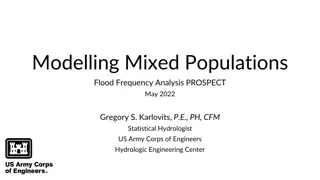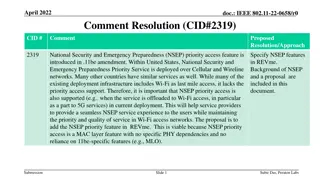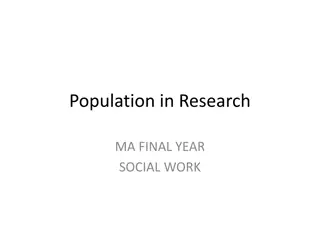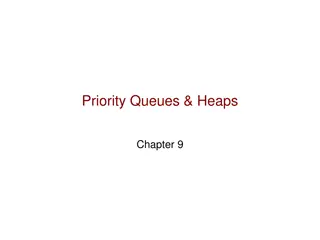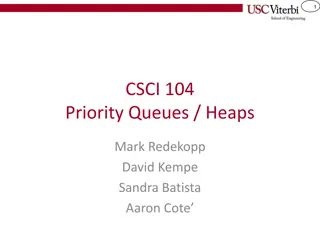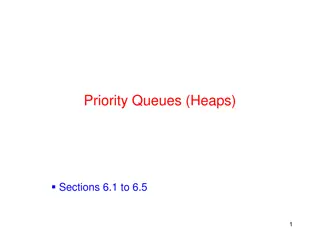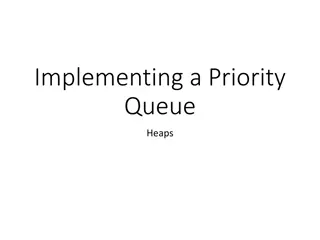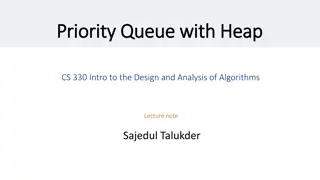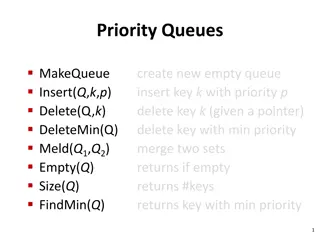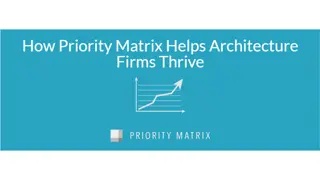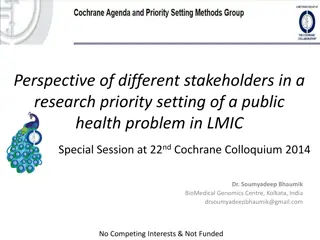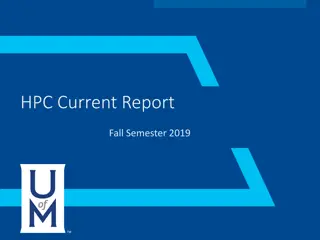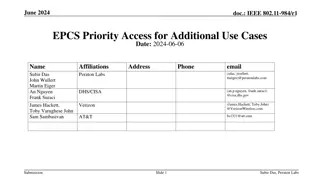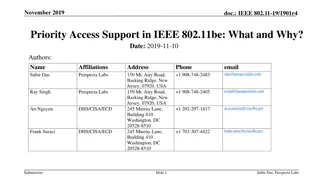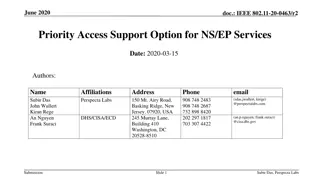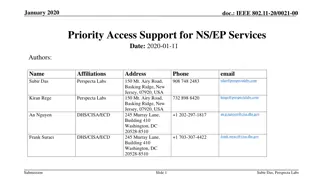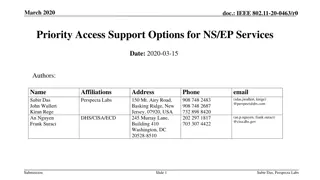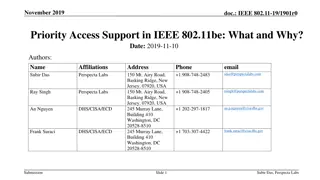A Concurrency Framework for Priority-Aware Intercomponent Requests in CAmkES on seL4
This research work proposes a concurrency framework designed to handle priority-based intercomponent requests efficiently in CAmkES on seL4. The framework supports reentrant execution, locked critical sections over shared state using IPCP, NPCS, and PIP protocols. It requires minimal changes to comp
0 views • 8 slides
Priority Activities and Action Plan for EW4All Infrastructure Commission: INFCOM-3 Session
The document outlines the priority activities and action plan for the Third Session of the Infrastructure Commission (INFCOM-3) within the Early Warnings for All initiative. It includes background decisions, a draft list of priority activities, and an action plan for contributions to the initiative.
5 views • 10 slides
Enhancing Health Data Usage for Transient Populations in Malawi
Exploring the challenges and successes in using health data for transient populations in Malawi, this presentation covers migration trends, potential opportunities, and recommendations for data use and exchange. Case studies illustrate the complexities of managing health data for mobile populations,
1 views • 15 slides
Mixed Populations in Flood Frequency Analysis
In this presentation by Gregory S. Karlovits, P.E., PH, CFM, a statistical hydrologist from the US Army Corps of Engineers, the focus is on modelling mixed populations in flood frequency analysis. The key topics include revisiting the IID assumption, identifying mixed populations, and building model
1 views • 38 slides
Proposal to Add National Security and Emergency Preparedness Priority Access Feature in IEEE 802.11be Amendment
The document proposes integrating the National Security and Emergency Preparedness (NSEP) priority access feature into the IEEE 802.11be standard to ensure seamless NSEP service experience, particularly in Wi-Fi networks used as last-mile access. The NSEP priority feature at the MAC layer is indepen
5 views • 12 slides
IEEE 802.11-20/0021-00 Priority Access Support for NS/EP Services Overview
This document discusses the importance of priority access support in IEEE 802.11be for National Security and Emergency Preparedness (NS/EP) services. It outlines the need for standardized mechanisms to ensure priority services in WLAN networks during NS/EP events when cellular coverage is unavailabl
2 views • 15 slides
Research Populations in Social Work Studies
Research populations in social work studies play a crucial role in forming the basis for data collection and analysis. The definition, types (target and accessible populations), and challenges faced by researchers in testing entire populations are explored in this informative content.
0 views • 5 slides
Priority Queues and Heaps in Java Collections
Explore the concepts of priority queues, heaps, and related data structures in Java Collections Framework. Learn about the Priority Queue class, Entry ADT, Comparator ADT, and Total Order Relations, along with their practical applications in process scheduling and more.
0 views • 44 slides
Heaps and Priority Queues in Data Structures
Exploring the concepts of heaps, priority queues, and the Priority Queue ADT in the context of data structures. Topics include the implementation of priority queues, comparing different data structures for efficiency, and the behavior of operations like insert and removeMin.
0 views • 40 slides
Priority Queues and Heaps in Java
Explore the concepts of priority queues, heaps, and their implementations in Java. Learn about efficiency tradeoffs, interface vs. implementation, and the primary operations of priority queues. Discover the importance of comparable elements and the various data structures used for efficient operatio
0 views • 49 slides
Priority Queues and Heaps in Data Structures
Priority queues prioritize item retrieval based on value, contrasting with traditional queues that follow a first-in-first-out approach. Priority queues efficiently manage items based on their importance, often utilized in scenarios like emergency rooms or air traffic control. Heaps, a form of binar
0 views • 20 slides
Priority Queues and Heaps
Priority queues differ from regular queues by maintaining an ordering of items based on priority rather than first-in-first-out. Items in a priority queue are assigned priority values and the highest priority item is removed first. Different data structures can be used to efficiently insert and remo
0 views • 54 slides
Priority Queues and Heaps in Data Structures
Priority Queues are data structures that support operations like Enqueue, Dequeue, Insert, and deleteMin, where elements are ordered based on priority. This article covers various aspects of Priority Queues, including their implementation, applications in operating systems, and the concept of Binary
0 views • 25 slides
Binary Heaps: Efficient Data Structure for Priority Queue Operations
Explore the concept of binary heaps, a specialized type of binary tree that allows for quick retrieval of the smallest (or largest) element. Learn how binary heaps excel in finding the minimum value, essential for priority queue applications in operating systems, event simulations, and more. Compare
2 views • 34 slides
Implementing a Priority Queue with Heaps
Learn about implementing a priority queue using heaps. Priority queues are essential data structures that maintain a special ordering property. The use of binary trees and heaps is explained in detail, focusing on maintaining shape and heap properties during insertions.
0 views • 57 slides
Priority Queues and Heap Data Structures
Priority queues play a key role in computer science algorithms by managing data based on priority levels. The use of heap data structures enhances the efficiency of priority queue operations. This tutorial covers the basics of priority queues, their applications, different implementations such as li
0 views • 30 slides
Priority Queues in Java: Implementation and Use Cases
Explore the concept of priority queues in Java, covering implementations using unsorted and sorted linked lists, as well as heaps. Learn about the differences between a queue and a priority queue through reading quizzes and discover various priority queue implementation options. Dive into priority q
1 views • 42 slides
Priority Queues: Operations and Implementations
Priority queues are data structures that allow efficient insertion, deletion, and retrieval of elements based on their priority. This information-rich content covers various aspects of priority queues, including ideal times, binomial queues, Dijkstra's algorithm for single-source shortest paths, and
0 views • 11 slides
Priority Queues and Heaps in CS2110
Delve into the realm of priority queues and heaps in the context of CS2110 during the Fall of 2015. Explore the differences between heaps and Binary Search Trees (BSTs) through desirable properties and advantages each structure offers. Discover how stacks and queues are implemented as restricted lis
1 views • 50 slides
Priority Queues and Heaps in Data Structures
Exploring the concepts of priority queues, heaps, and various data structures like linked lists, binary search trees, and interfaces like Bag. The content covers comparisons between BSTs and heaps, efficiency purposes in data structures, and implementations of stacks and queues. Learn about the sign
0 views • 50 slides
Priority Queues and Heaps in CSE 373 Lecture
Today's lecture in CSE 373 covers the Priority Queue Abstract Data Type (ADT), the properties of heaps, and their implementations. Key topics include the completeness property of heaps, different priority queue implementations such as the binary search tree for faster insert and find operations, and
1 views • 21 slides
Priority Setting in Healthcare in Chile: Social Value Judgements and Health Programmes
The presentation discusses the context of priority setting in healthcare in Chile, focusing on social value judgements and the principles of national health programmes with universal coverage. It highlights key statistics about Chile's healthcare system, including population, GDP per capita, and hea
0 views • 20 slides
Priority Matrix in Teams
Priority Matrix is a valuable tool in the A/C/E industry, allowing teams to prioritize tasks efficiently, communicate priorities effectively, and track progress accurately. Real teams benefit from its use cases in prioritization, communication, and progress tracking, creating a roadmap for workflow
0 views • 23 slides
DHHS Coordination of Transportation Service Contracts Overview
The Department of Health and Human Services in Maine conducted an assessment of Transportation Services in June 2019. The workgroup identified three main priorities: alignment of Quality and Performance Measures, Safety Measures, and Evaluation of Transportation Services. The first priority involves
1 views • 28 slides
Stakeholder Perspectives on Research Priority Setting for Public Health in LMICs
Stakeholders in a special session at the 22nd Cochrane Colloquium 2014 discussed the importance of involving diverse stakeholders in research priority setting for public health issues in Low- and Middle-Income Countries (LMICs). Key topics included barriers to patient involvement, challenges in addr
0 views • 13 slides
Proposals for Prioritizing Bids and Managing Collateral Requirements in Auctions
Market Participants face significant collateral requirements in auctions due to multiple bidding zone borders. Proposal to assign priority to bids for credit limit reasons aims to address randomness in bid rejection. Bid XSD is extended to include priority as a component, enhancing bid management ef
1 views • 6 slides
Overview of Fall Semester 2019 HPC Current Report
The Fall Semester 2019 HPC Current Report highlights changes made in resource allocation, job queue management, utilization analysis, and factors influencing job priority. Key modifications include adjusting memory per CPU, implementing limit enforcement, and changing fairshare weights. The report d
1 views • 20 slides
Suicide Prevention Advisory Group Monthly Meeting Summary
The Suicide Prevention Advisory Group held their monthly meeting discussing collaboration with SMEs, funding priorities, consensus panel timeframe, portfolio reorganization in ISRM, AMP development, survey data review, and priority setting process. They also reviewed initial results from the SP Prio
0 views • 39 slides
Online Registration of Interests in Receivables: All About Interests and Priority Positions
Delve into the intricacies of online registration of interests in receivables, understanding the significance of registration, the impact on priority positions, and the necessity of proper documentation. Explore the current positions in receivables financing, priority rules in assignments, the effec
2 views • 12 slides
2021 Consolidated Annual Performance Evaluation Report
This report presents the Consolidated Annual Performance Evaluation Report (CAPER) for 2021, highlighting public health services, HUD planning processes, required plans, funding amounts, goals, and priority needs. It covers AHD programs such as CDBG, HOME, ESG, and HTF, along with the goals and prio
0 views • 24 slides
Equivalence Between Priority Queues and Sorting in External Memory
This study explores the relationship between priority queues and sorting in the context of external memory, shedding light on their equivalence. The work delves into the intricate connections and implications of these fundamental data structures, offering insights into their practical applications a
0 views • 32 slides
EPCS Priority Access for Additional Use Cases
This presentation delves into EPCS Priority Access in IEEE 802.11 for emergency preparedness communications during critical situations. It discusses the need for prioritizing access to support essential use cases and addresses regulatory updates concerning Wireless Priority Service in the USA.
0 views • 10 slides
Priority Room Selection 2012-2013 at UNLV Housing & Residential Life
Priority Room Selection (PRS) at UNLV Housing & Residential Life offers financial incentives, room preferences, and exclusive benefits for current residents to choose their accommodations for the upcoming year. Learn about the process, benefits, dates, and how to participate effectively. Make inform
0 views • 15 slides
Priority Queues: Understanding Heaps
Master the concept of priority queues using heaps. Explore the intricacies of implementing and working with priority queues in your applications. Learn how heaps optimize access to elements based on their priority levels, enhancing the efficiency of your algorithms.
0 views • 22 slides
Priority Queue in Data Structures & Programming
Priority queues are fundamental data structures storing elements based on priorities rather than positions. Learn about priority queue models in modern life, the application of priority queues, key concepts like keys, priorities, total order relations, and more. Explore how priority queues are used
0 views • 19 slides
Priority Access Support in IEEE 802.11be for National Security and Emergency Preparedness
Explore the introduction of priority access support in IEEE 802.11be for National Security and Emergency Preparedness (NS/EP) services, addressing the increasing need for priority support over Wi-Fi access in critical situations. Learn about NS/EP priority services, their background, objectives, cur
0 views • 19 slides
Priority Access Support for NS/EP Services in IEEE 802.11be Standard
Enhance your understanding of the priority access support for National Security and Emergency Preparedness (NS/EP) services as proposed in the IEEE 802.11be standard. This presentation outlines the objectives, existing NS/EP priority services, and the need for a standardized mechanism to ensure prio
0 views • 17 slides
IEEE 802.11 Wireless Network Priority Access Support Overview
Explore the potential for priority access support in IEEE 802.11 networks, specifically for National Security and Emergency Preparedness (NS/EP) services. Learn about the objectives, challenges, and benefits of standardized mechanisms to enhance priority services in WLAN environments. Discover the e
0 views • 15 slides
Support Options for NS/EP Services in IEEE 802.11-20-0463/r0
Explore the priority access support options for National Security and Emergency Preparedness services in the IEEE 802.11-20-0463/r0 document. Learn about providing priority access to system resources, authorized users, and existing NS/EP priority services in the US and globally. Discover how priorit
1 views • 14 slides
Priority Access Support in IEEE 802.11be: Enhancing National Security
This document explores the implementation of priority access support in IEEE 802.11be to facilitate National Security and Emergency Preparedness services. It discusses the background, objectives, current gaps, and capabilities needed for supporting priority services. Additionally, it highlights the
0 views • 18 slides



